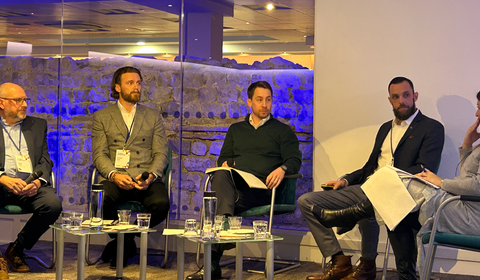Energy companies have complex risk profiles, with significant liability, workers’ comp and regulatory exposures. Claims are often far from straightforward, but utilizing AI to gather information can help to simplify and streamline the process.
The energy sector encompasses multiple industries – utilities, oil and gas and renewable energy – and each comes with its own unique set of risks and potential claim scenarios. General liability, auto liability, workers’ compensation and regulatory compliance exposures are all significant for energy companies. Managing claims efficiently is critical to minimizing loss, but it is a complex undertaking.
Today, claims administrators are deploying advanced technology to move claims forward more quickly and resolve them more fairly.
Here are some of the factors that make energy sector claims so complex and where technology can help to simplify things.
1. Multiple stakeholders and a web of contracts
Work sites in the energy industry often employ multiple contractors and subcontractors.
“When incidents like explosions or accidents involving dropped objects occur on well sites or plants, the biggest challenge is navigating the complex web of contracts between the various companies present. The first step is to obtain all the applicable contracts, particularly the master service agreements, to determine the relationships and obligations between our client and the employers of the injured parties,” said Ashley Morgan, AIC, liability claims trainer, Broadspire.
“It's crucial to identify any contractual indemnity obligations. In one current case involving an explosion that burned two people from different companies on the same well site, we had to tender claims to different entities based on the specific master service agreements in place with other entities involved.”
Identifying relevant stakeholders and determining liability for large losses can be intensely time-consuming and requires a high level of attention to detail.
2. Complex contract language
Contract language interpretation can be a significant hurdle in complex claims, often leading to prolonged litigation.
“In one recent property damage claim, a company hired a temp worker through an agency. The worker, operating a client-owned forklift, improperly loaded pipe onto a third party's DOT-compliant tractor, causing damage and rendering it inoperable,” Morgan said.
“There was a dispute between the client and temp agency over which contract applied, as one was signed before the other and they had conflicting terms. Even after the temp agency acknowledged the client’s additional insured status, there was a dispute over reimbursing the legal fees due to the deductible program. Ultimately, they did pay but only after a year of litigation, all because of the inability to agree on the meaning and applicability of contract language.”
Sorting out applicable contracts and deciphering language quickly can alleviate significant claim management delays and increase costs – and frustration – for all involved.
3. High risk activities
There are inherent hazards associated with energy operations.
“The sector deals with flammable, explosive and toxic materials, as well as high-pressure systems and heavy machinery. This heightens the risk of accidents, injuries and environmental incidents, which can lead to significant claims,” said Theresa Addison, liability team manager, Broadspire.
“Exacerbating this is the scale and complexity of energy projects. These often involve large-scale infrastructure, specialized equipment and a diverse workforce. As a result, claims can be substantial and multifaceted, requiring expertise in various areas such as property damage, business interruption and liability.”
4. Regulatory scrutiny
The energy sector is subject to significant environmental regulations that add a layer of risk to all activities. Regulations can vary from state to state, complicating the exposure for energy companies that operate in multiple areas.
“Claims can arise from regulatory violations, environmental damage and public liability issues. Managing these claims requires a deep understanding of the legal and regulatory landscape, as well as effective communication with stakeholders,” Morgan said.
Regulations can also change from year to year, meaning risk and claims professionals need to stay continually on top of shifts in the regulatory landscape as they unfold.
How technology can help
New tools utilizing artificial intelligence are emerging to help answer liability questions and streamline the claim management process from start to finish.
Smart dash cams are one example. Auto liability is a big exposure for energy companies. Not only are there lots of big rigs transporting materials to and from sites, but many employees also use company cars for personal use as well. Accidents, especially ones involving severe bodily injury or death, result in significant claims. Sorting out who’s at fault has historically been a lengthy process. Inward and outward facing cameras help to answer those questions quickly and definitively.
“Dash cams and telematics offer significant benefits from a claims adjuster's perspective. The AI component of these cameras can provide valuable insights, such as identifying the percentage of drivers who were distracted. This information helps in implementing targeted training programs and risk management strategies, like disabling work phones while driving,” Morgan said.
Fleet telematics systems also provide details such as the specific location and time of an incident, rate of speed of the vehicle, sudden braking or lane shifting that might have contributed to an accident. Along with video footage, this information can bring clarity to claims that otherwise can involve a lot of back-and-forth and finger-pointing.
AI is also being deployed to tackle the feat of reviewing contracts. Broadspire has implemented its newest tool to streamline the claims process and enhance efficiency and accuracy.
AI’s power to cut through
The language recognition capability of AI enables it to review thousands of pages in minutes and identify key words. Comparing contracts against policy language helps claims professionals determine liability and applicable coverages.
“Policies can be incredibly cumbersome, often spanning hundreds of pages with state-specific endorsements and details. For someone who doesn't regularly review policies, navigating this complexity can be daunting and time-consuming. That's where our AI technology shines,” Addison said.
“It extracts the exact language we need to examine from both the policy and the contract. Armed with this information, we can efficiently provide our findings to the carrier, enabling them to swiftly draft a response. This significantly accelerates the entire process. Normally, carriers can take up to 60 days to make these decisions, which can significantly delay the claim,” she added.
By making it easier and more straightforward to distill details and share them quickly, Broadspire’s AI technology enhances communication and collaboration among carriers, clients and the claims team. This ultimately improves claim outcomes and increases client satisfaction. Broadspire builds AI into its new-hire training program, so that the next generation of claims professionals is prepared to leverage new technology easily. “These technologies prove incredibly beneficial for claims adjusters, providing crucial evidence and insights to accurately assess and resolve claims,” Addison said.
“For complex industries like the energy sector, the ability to streamline claims will produce huge efficiency gains over time.”
Beyond simply validating coverage, Broadspire’s systems proactively identify claims likely to be litigated, those with subrogation potential, those that can be resolved quickly and others that require additional attention.
Want to learn more? Download our sales sheet here.



